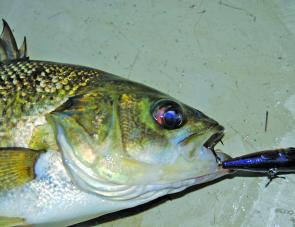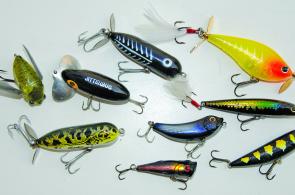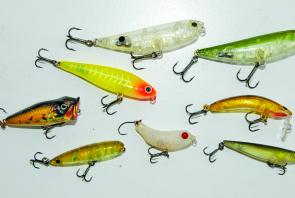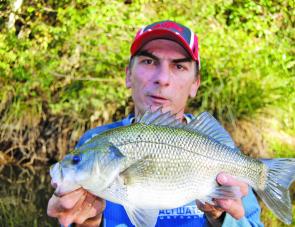At this time of year one of the most popular styles of fishing around the southeastern part of the country is casting surface lures to bream and bass.
Both species can provide us with plenty of exciting surface action, but as much as they love to smash something on the top, bream and bass can be moody and difficult to tempt at times.
These two fish share a number of behavioural traits, even though they are very different.
Both tend to hit surface lures more aggressively when the weather and water temperatures are warm and become hesitant about hitting surface lures if the temperatures suddenly fall, such as just after a southerly change or a few cooler rainy days.
Bass and bream are both also quite opportunistic feeders: they will eat a wide variety of food and adapt to whatever the environment throws at them.
If one food source suddenly becomes more abundant, such as a big insect hatch they may also focus more on that and will become disinterested in most other potential food items.
One week they may be willing to strike at almost anything we throw at them, then the following week we have to sift through the tackle box to find a lure they’ll attack.
Apart from bream frequenting salt water and bass living in the fresh, the main difference between the two is that bass are easier to catch than the more wary bream.
Through the warmer months one of the main sources of food for bream are prawns, closely followed by the smaller glass shrimp.
Even if they are munching away on an oyster or sifting through the silt looking for worms or muscles, if a prawn pops out in front of them, bream are very much inclined to attack it.
The majority of our surface lures are roughly the equivalent of a prawn or shrimp to a bream.
Regardless of exactly which type of surface lure you’re using, I always tell people to try and forget that it’s a lure on the end of the line and attempt to make your offering behave as much like a real live prawn as possible.
If you look at the way a prawn behaves when being chased down by a determined bream, it won’t just half-heartedly plop along in a dead straight line at the same pace. A frightened prawn will jump around in different directions and move as fast as possible, occasionally stopping dead still.
The more we make a surface lure act like a prawn on death row, the better our chances are of getting the bream to savagely hit the lure. So make your surface lure retrieves a bit more radical, with those all important pauses along the way.
There are also times when insects fall from trees and become part of a bream’s diet.
What does an insect like an ant, beetle or cicada do if it falls from a tree into the water? Not much.
So during the height of summer, when fishing timber lined creeks it makes a lot of sense to simply cast the lure out and do nothing. If bream are within 2m of where the lure falls, they’ll probably know straight away and rush over to it.
Before they strike though, they may hover below, having a good hard look to make sure everything is ok.
If anything looks a bit wrong or scary, they won’t hit it. If you’re confident that your lure has landed right near a bream, just leave it sit there for a while, before commencing the retrieve.
Even after moving it a metre or two, give the lure another long pause, it may get smashed then.
In smaller timber lined creeks bass will act exactly the same as bream when it comes to eating insects, so once again it makes sense to leave a lure sit there for a while before retrieving.
However when targeting bass you can leave a lure sitting there, dead still, for much longer than when fishing for bream. If you have the time and patience, then leave the lure sit for two or three minutes.
In some of the larger rivers bass also love a feed of herring.
Herring obviously behave quite differently to fallen insects, so a surface lure like a long thin stickbait that is dog walked across the top has a very good chance of getting clobbered by a bass.
A wide range of other potential bass food items include ants, termites, moths, worms, small snakes, lizards, crayfish, prawns, shrimp, frogs and even strange stuff like baby birds that may fall from their nest.
This is why bass are more inclined to hit larger and weirder looking lures than bream. So never make the mistake of thinking a lure looks too silly to cast where bass may live.
Although you can catch both bream and bass on surface lures right through the day, they will generally respond better to something on the top earlier in the morning or later in the day.
This is particularly the case with bass, however bream may remain more active right through the day and we should also bear in mind that bream are more heavily influenced by the tides where applicable. On the flip side, bass tend to remain active well into the night.
Small poppers or stickbaits that can be dog walked across the top are the best styles to cast for bream.
Sizes from 35mm to 65mm and lighter, natural colours or even clear lures tend to be quite good.
Some primes examples are River2Sea Bubble Pops, Maria Pencils, Luckycraft Bevy Poppers, Luckycraft NW Pencils and the Luckycraft Sammy 65. Of course, other lures similar to these will also work.
There is an enormous range of good bass lures available. Darker colours like purple or black can be relied upon and suitable sizes may range from 40mm to 80 mm.
Old style lures like the Arbogast Jitterbug and Heddon Torpedo still stack up well alongside the new breed like Megabass Sigletts, Luckycraft Bevy Props and the Jackson B Pivot, amongst others.
Bream may take surface lures meant for bass and vice versa. So if you’re fishing in an area where both species are on the cards it’s probably best to stick to more ‘breamy’ style surface lures, as bass are still likely to hit those.
Some that I would recommend in this category include Jackson T Pivots, Luckycraft NW Pencils, Maria pencils, River2Sea Bubble Pops and the new Viking Pop’n’Crank.
Reads: 14176
This bass smashed a small popper off the surface.

Bream are a little more wary than bass and are sometimes harder to temp.

These bass lures represent a number of different creatures that bass feast on the in water.

A selection of top bream lures, most of which resemble a prawn in the water.

The author with a great fat bass taken on a surface lure.

Stonker bream like this one hit hard on the surface and are a great catch.




